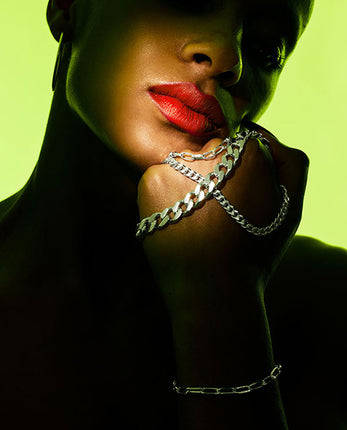Tips For Buying Gold

Gold
Gold is the ultimate in luxury and for that reason, will always be in fashion. Solid gold jewellery is a purchase that you will be able to enjoy for life, even generations, so before you make a purchase it is wise to educate yourself on the different standards of gold available so that you buy the best that you can afford. Below are the key facts everyone should know about gold and what to look out for as a shopper.
1. Gold is measured in 24ths,
so 24 carat is 100% gold
24 carat is the highest purity available and consists of 99.9% gold. However, 24 carat gold is not used to make fine jewellery. It would be too soft to hold it shape and therefore not safe for setting stones.
Gold is naturally yellow and highly valuable, but it is also soft and malleable. The addition of other metals (alloys) to gold are used to increase the toughness and hardness of the metal, to change the colour i.e. white gold (palladium or silver) and rose gold (copper) and in the case of lower carat gold, to lessen the cost.
18 carat gold is 75% pure gold (18 parts out of 24 pure gold and 6 parts alloy).
14 carat gold is 58.5% pure gold (14 parts out of 24 pure gold and 10 parts alloy).
9 carat gold is 37.5% pure gold (9 parts out of 24 pure gold and 15 parts alloy) .
The most widely used alloys for jewellery in Europe are 18 and 14, although 9 is very popular in the UK and parts of Europe. In the United States and Canada, most fine jewellery is 18 carat, but 14ct is the most popular, followed by 10ct (they do not sell 9ct gold).
**18 carat gold is ideal for allergy sufferers as it does not cause allergic skin reactions. 14 carat is adequate for most metal sensitivities.

2. Carat is the measure of purity
The higher the carat the more valuable the gold. In most parts of the world, the terms carat and karat are used interchangeably (in the USA the designation for gold fineness is karat). Both carat and karat are derived from the word for the carob seed, which were used as measurements of weight in Oriental markets.
The weight of gold in jewellery is measured in grams. Most countries require every item of gold jewellery be clearly stamped with its carat which is usually controlled through hallmarking. Gold prices fluctuate depending on the market demand (in times of conflict, political uncertainty, or currency fluctuation, many invest in gold or platinum for financial stability).

3. Hallmarks
A hallmark is a guarantee of metal purity. Hallmarking is a system that originated in London at Goldsmiths’ Hall in the 14th century. In the UK and in Ireland there are three compulsory hallmarks applied to precious metals as a quality control: a sponsor’s (maker’s) mark, a fineness mark (purity), and an assay office mark. These marks establish the origin and fineness of the precious metal and ensures it has been accurately and independently tested (assayed).
In Hallmarking the metal and fineness mark for 18 carat is 750. The mark for 14 carat gold is 585. The mark for 9 carat is 375. In the United States, the Federal Trade Commission does not require a gold fineness stamp; however, if one is used, it must be accompanied by the manufacturer’s mark.
Note: A branding mark should not be confused with a legal hallmark.
Irish hallmark examples:


Here is how it applies to you as a shopper!
It is important to be aware that hallmarking is the law in the UK and Ireland (and many other countries).
A jewellery shop can not sell something as 18 carat gold, 14 carat etc. unless it has been hallmarked (tested to prove that it is in fact the carat claimed or higher). So if someone advertises something as gold, look for the hallmark (750, 585, 375...). If it's not there you are perfectly within your rights to ask why?
Beware of vague or misleading labels. Magazines and fashion retailers will often list something as "gold" when they should say "gold coloured", "gold tone" or "gold plate".
18 carat gold-plate is not 18 carat gold! What is underneath? Is it a quality vermeil - hallmarked sterling silver (925) plated in carat gold or is it a cheap base metal? Will it make your skin turn green when the plating wears off? If you find a piece of jewellery that is only twenty or 30 euro more in "gold" than it is in "silver", then it isn't gold.
Gold is much more valuable than silver and also heavier (more dense) than silver, which is why it is much more expensive. Check the hallmark! Once you know what you are paying for and are happy with the metal and the price, then go for it!
Gold vermeil is a wonderful way to have great jewellery at a reasonable price, especially for large statement pieces such as our Mixed Tape or Rugged Ring, but if you want to enjoy your gold jewellery for years to come, without fear of fading, invest in the real thing. Nothing replaces the look or feel of solid gold (plating, no matter how good, will eventually wear off).

Q: What is Vermeil or Gilded Silver?
A: Vermeil (pronounced vur-may) is produced by coating sterling silver with carat gold. Sometimes referred to as gilded silver or gilt, vermeil is made using the process of electrolysis — electricity and an acid bath — to attach the gold to sterling.
To be considered vermeil, the gold should be at least 10 carat and be at least 1.5 microns thick. This layer of gold is thicker than that applied using the electroplating process used in gold plate, but it will still wear off over time. If it is hallmarked it will be 925 for sterling silver. At Edge Only we use 18 carat gold to plate our sterling silver '18ct gold vermeil' designs.

At Edge Only we only use solid sterling silver and solid 9 carat, 14 and 18 carat gold, hallmarked in accordance with UK and Irish law. We do NOT use gold plate or goldfill. For your information, please find below some common terms and techniques used in the wider jewellery and costume/fashion jewellery world.
Q: What is Gold Plate?
A: Gold Plated jewellery is non-precious or "base metal" jewellery that has a very thin layer of the precious metal electroplated to it. The thickness of gold (or silver if silver plated) is generally only a few microns thick. The metal underneath the plating is a base metal (pot metal or brass) that is able to conduct electricity allowing the bonding process to work. The plating will wear off.
Q: What is Gold Filled, Rolled Gold or Bonded Gold?
A: Gold Filled is composed of a layer of gold bonded with heat and pressure to a base metal (or alloy) such as brass. The bond produced is a permanent one and the gold is thicker than that of gold plate.
A gold filled item must contain a fifth (1/20th) of its weight in gold and will have a quality mark that will identify its carat. For example, 14 carat Gold Filled will be marked as 14/20, meaning that the outer 1/20th of the piece is 14ct gold, the remaining majority of the piece is brass or base metal. This is not a hallmark and should not be confused with hallmarked precious metal.
Gold is such a beautiful, valuable metal. It is an investment that will be enjoyed for life and passed on through the generations. It is a luxury thats holds its value. I hope that this information will be helpful to you when you wish to make a purchase.
View Edge Only's gold

www.edgeonly.com
Luxury jewellery with an edge, sustainably made in Ireland.
You may also enjoy our blog What Are Laboratory-Grown Diamonds?


